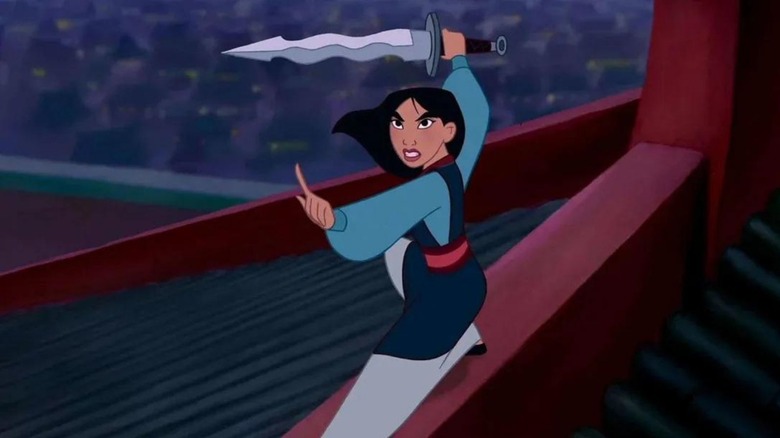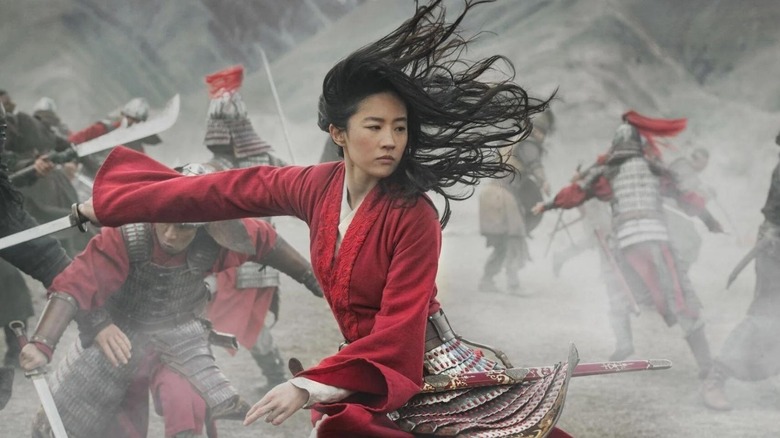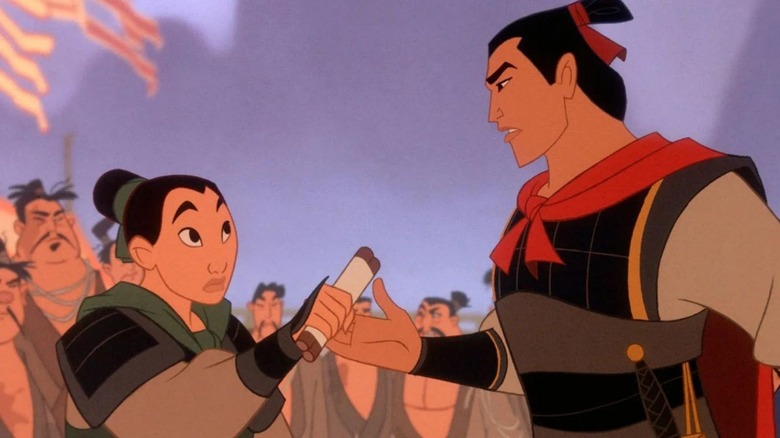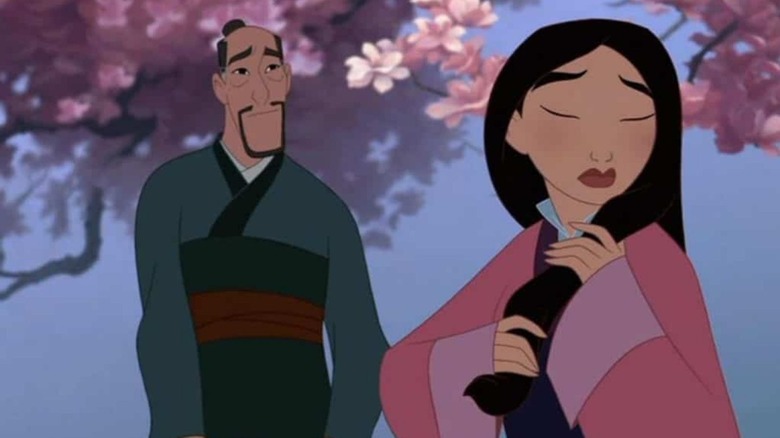The Differences Between The Real-Life Mulan And Disney's Adaptation
Disney's "Mulan," the 1998 animated film about a young, fearless girl who impersonates a man to enlist into the Chinese military, is a story that has been told and retold for over 1,500 years. It earned a controversial live-action adaptation in 2020, with several story elements changed to accommodate a new generation of audiences. But at its heart, Disney's "Mulan" is a story about a young girl who rejects traditional femininity and aims at breaking the status quo within her society.
The film is adapted from a beloved Chinese legend and highlights Mulan's journey as a woman living in a patriarchal regime and fighting in the Chinese military. While the animated film features musical numbers and training sequences, the live-action movie establishes Mulan's presence as a warrior. Her Qi (Chi; the life force within every entity) is strong and naturally intuitive. She eventually proves her worth to the Chinese Empire and brings glory to her family.
Despite having different interpretations, both films are inspired by the Chinese poem titled "The Ballad of Mulan," one of the oldest known versions of Mulan's story. It's a folktale from an anonymous poet written during the Northern Wei Dynasty (386-534 AD) about a girl who goes to war in place of her father. The 360-word poem has inspired countless retellings over the years and is the basis for both the animated and live-action film — but there are plenty of differences between the two adaptations.
The Ballad of Mulan dates back to the 6th century
The Chinese poem simply describes Mulan's story, not offering much detail about the character itself. The poem might have made Mulan an enduring Chinese heroine, but it contains a limited overview of a decade in her life.
When the poem begins, Mulan is at the loom, weaving. She soon discovers that her elderly father is being called away to war, but he has no grown-up son to send in his place, only her little brother. Mulan decides to take matters into her own hands and takes her father's place. So she sets aside her loom, buys a horse, a saddle, and a whip, and rides off to war.
A short paragraph describes Mulan's experiences in the war — she fights in over 100 battles, crosses passes and mountains, and travels 10,000 miles. A decade has passed when she returns, having fought valiantly, and the Emperor offers Mulan prizes and promotions. Instead of any exquisite gifts, she asks for a horse (or donkey, depending on the translation), so she may return home to her family.
Mulan is reunited also with her parents when she returns and resumes her old life quickly enough. She takes off her soldier's uniform and dresses in her old clothes, setting her hair and applying make-up to her face. When she steps out to meet her comrades from the war, they're shocked. Despite fighting alongside her for years, they never once imagined Mulan was a girl. Mulan then explains the situation using an analogy about rabbits in the poem: You only know a rabbit's gender if you trap it. See it sitting in a field, and you'll never know its sex, an idea the poem implores its reader to think about.
How do the poem and films differ?
The characters in "The Ballad of Mulan" and Disney's adaptation are the same, but the motivations that drive them are different. In the legendary poem, Mulan is purely driven by her sense of duty towards her elderly father. She decides to enroll as a soldier to save him from possible death, and after completing her obligation to the Chinese Empire, she returns to her old life with no qualms.
The films, however, reimagined the enduring heroine as a tomboy who rejects traditional gender roles and seeks a life beyond marriage. When she picks up a sword and mounts her horse, Mulan does it for her father but also for herself. She strives to bring honor to her family, despite being told that the only way she could do that is by securing a man in marriage. While the animated Mulan is offered a position on the Emperor's Royal Council and rejects it, choosing to return to her family, live-action Mulan is requested a second time and implored to think about her refusal. Moments before the screen goes black, the 2020 film goes as far as suggesting that Mulan may choose to take her place in the Emperor's Imperial Guard after all and not renounce her sword for a life gone by. Unlike the one in the poem, this Mulan appears to choose herself.
The ballad touches upon Mulan's understanding of duty and her position as a courageous warrior. But it rarely explores her life as a soldier, one that must have indeed been rife with its own set of trials and tribulations, never putting to words the struggles Mulan must've had to face as a woman in a man's armor. The poem only addresses how Mulan rejects the gender binary — almost accidentally — because a far more significant motivation drives her intentions.
In the ballad, Mulan joins the army because of her father. The films forsake this notion because here, Mulan is informed by her ambitions and her dream of being something more — she wants to bring honor to her family but not necessarily in the way it is expected of her. So she trades her Hanfu dresses for her father's armor and rides off at dawn, training alongside other soldiers and earning a rightful place in the Imperial Army.
The animated film and live-action version feature other differences, such as the live-action's erasure of Mushu the dragon, the animate film's musical numbers, and the presence of Li Shang, Mulan's love interest. But the endings are still the same — Mulan is honored for her unmissable talent and offered a place in the Imperial Army, despite being a woman. Instead of disregarding gender roles, there's a different wish that Mulan in the ballad is concerned about fulfilling — filial piety.
Filial piety in Mulan
In Chinese culture, xiào (or filial piety) has a deep-rooted history. Influenced by Confucian thought, it has been a concept of Chinese philosophy for over 3,000 years. It entails a strong loyalty and deference to one's parents, ancestors, and by extension, to the country and its leaders. In part, it is demonstrated through service to one's parents and is still primarily observed today. The concept is reflected in Mulan's story, too, where a woman sheds her femininity and cross-dresses as a man to take her father's place in the army. But when her tour is done, she goes back to her old life with no qualms. "The Ballad of Mulan" is symbolic of the rigidity of gender roles and expectations in China, because if Mulan had joined the army of her own volition, the story would be very different.
The ballad's ending only emphasizes its value. By returning to her old life, Mulan proves she has fulfilled her filial piety by venerating her father. The films, instead, reinvent Mulan, making sure that her choices remain her own. And some people didn't particularly like that.
When the animated film was released, China didn't have the reaction Disney expected. In Mulan's Legend and Legacy in China and the United States (via Vox), Lan Dong reported that the film made only $1.3 million at the box office in China, which is one-sixth of the revenue they hoped for. The film was praised for endeavoring to understand Chinese culture but many thought that the Mulan from Disney's story was more American than Chinese.
The most prominent reason why the film wasn't as well-received as it should've been is because of the heroine being motivated by her own wishes rather than just filial piety, the most resonant theme in the poem. Mulan goes to war so her father's life may be spared, but she also makes that choice because she disagrees with her given status in society. Mulan proves that even as a woman, she can still bring honor to her family, whether she decides to give away her hand in marriage or chooses to wield a sword. But the choice is her's and her's alone.



